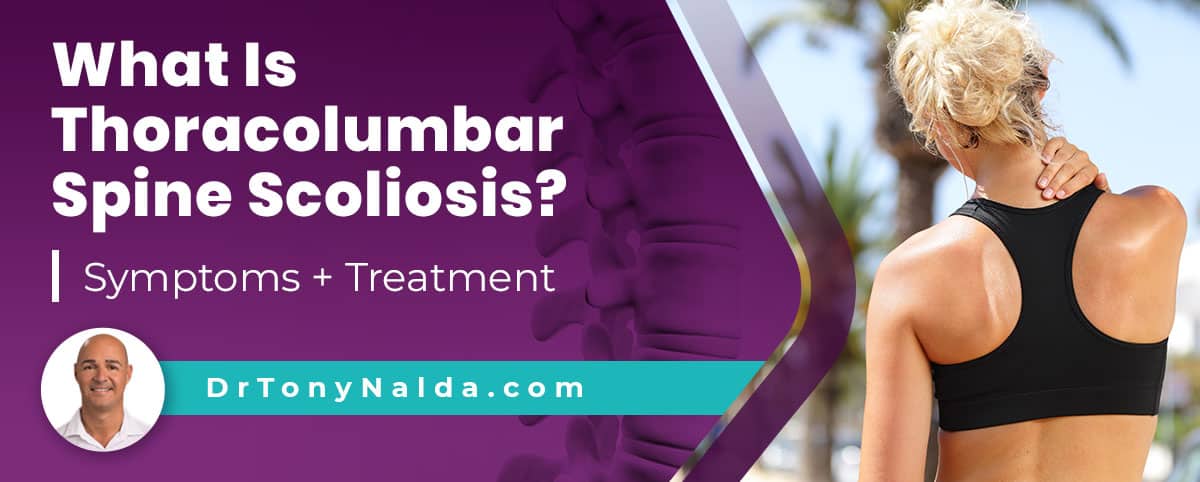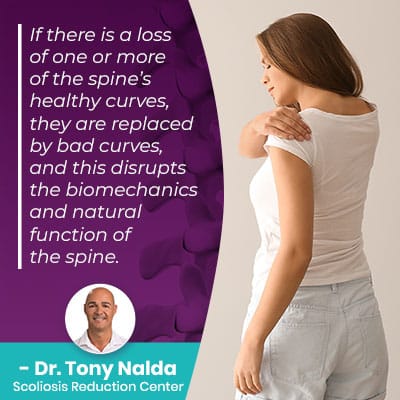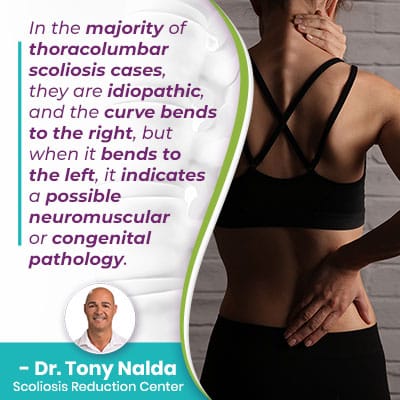What Is Thoracolumbar Spine Scoliosis? Symptoms + Treatment

Scoliosis is a complex condition to treat. Not only can it range from mild to moderate and severe to very severe, but there are also multiple condition types with unique causation and treatment needs. In addition, there are different curvature types and patterns that make further classifying conditions a necessity. Conditions are classified based on patient age, type (cause), condition severity, and curvature location.
The spine has three main sections, and curvature location is one of the condition’s classification points. Scoliosis can develop in any of the sections and can also involve multiple sections; if a scoliotic curve includes the lower thoracic and upper lumbar spine, this is thoracolumbar scoliosis.
To define thoracolumbar scoliosis, let’s explore some basic spinal anatomy and explain how/why a condition is further classified as part of the diagnostic process.
Table of Contents
Basic Spinal Anatomy
Knowing some basic spinal anatomy makes it easier to understand the importance of the spine and how a condition like scoliosis can affect it.
The spine helps us stand upright and practice good posture. It gives the body structure, enables flexible movement, and protects the spinal cord.
The spinal cord houses a column of nerves, and the brain and spine work in tandem to form the central nervous system (CNS): the body’s main communication highway.
As part of the central nervous system, the spine is involved in virtually every working system within the body, which is why spinal conditions can cause a myriad of effects felt throughout the body.
A healthy spine will have a soft ‘S’ shape when viewed from the sides and will appear straight when viewed from the front or back, and these healthy curves make the spine stronger, more flexible, and better able to absorb/distribute mechanical stress incurred during movement.
The spine’s natural curves make it act like a coiled spring; those curves are there to absorb force and make it stronger than if it were straight.
 If there is a loss of one or more of the spine’s healthy curves, they are replaced by bad curves, and this disrupts the biomechanics and natural function of the spine.
If there is a loss of one or more of the spine’s healthy curves, they are replaced by bad curves, and this disrupts the biomechanics and natural function of the spine.
The spine has three main sections:
- Cervical (neck)
- Thoracic (middle/upper back)
- Lumbar (lower back)
Each spinal section has its own characteristic curvature type, lordosis or kyphosis, that makes the spine either bend inwards towards the body’s center in a standard ‘C’ shape or outwards away from the body’s center in a reverse ‘C’ shape.
The cervical and lumbar sections feature lordotic curves, while the thoracic spine features a kyphotic curvature type.
The spine consists of vertebrae (bones of the spine) stacked on top of one another in a straight and neutral alignment and separated by intervertebral discs.
Now that we have a basic understanding of the spine and its structure let’s talk about how scoliosis affects the spine.
Scoliosis and the Spine
When scoliosis is diagnosed, it means an unnatural sideways spinal curve, with rotation, and a minimum Cobb angle measurement of 10 degrees has developed.
The rotational component is what makes scoliosis a 3-dimensional condition because the spine doesn’t just bend unnaturally to the side, but also twists from front to back, back to front.
A patient’s Cobb angle is a measurement obtained during an X-ray that involves drawing intersecting lines from the tops and bottoms of the most-tilted vertebrae at the apex of the curve, and the resulting angle is expressed in degrees.
Thoracolumbar spine scoliosis refers to a lateral spine curvature that encompasses both the thoracic and lumbar regions, often manifesting as an "S" shaped scoliosis. This condition can take the form of a dextroconvex curvature, characterized by a convex right scoliosis, and may be associated with various underlying causes, including idiopathic scoliosis or neuromuscular scoliosis, commonly diagnosed during adolescence or as a result of conditions like cerebral palsy, resulting in abnormal spine curves.
Thoracolumbar spine scoliosis refers to an abnormal curvature, such as dextrocurvature or mild dextroscoliosis, affecting the thoracic and lumbar regions of the spine, potentially manifesting symptoms based on the severity, necessitating appropriate treatment strategies, which may vary depending on factors like congenital scoliosis, degenerative changes, or specific conditions like infantile or juvenile idiopathic scoliosis.
Now that we know what parameters have to be met to reach a diagnosis of scoliosis let’s talk about how the condition is further classified, including curvature location.
Classifying Scoliosis
When scoliosis is first diagnosed, part of the process is comprehensively assessing the condition so it can be further classified based on important patient/condition characteristics: patient age, condition type (cause), severity, and location.
Classifying conditions is important because it streamlines the treatment process between different practitioners and care facilities and because the important classification points shape the design of effective treatment plans.
Patient age
Patient age is important because the condition can affect all ages, and when it comes to the progressive nature of scoliosis, age is a key factor because growth is the condition’s main trigger for progression.
So we know that young patients who have not yet reached skeletal maturity are at risk for rapid-phase progression, but adults who are no longer growing are not as likely to progress as quickly.
Patient age also indicates whether or not pain management will be necessary as part of a patient’s treatment plan; children and adolescents don’t commonly find the condition painful, but for adults, pain is the number-one symptom.
Condition Type
The type of condition is important because it dictates the condition’s treatment needs; when the cause is known, the underlying cause has to guide the design of treatment plans.
Most scoliosis cases (80 percent) are classified as idiopathic, meaning they are not clearly associated with one single cause and are thought to be multifactorial.
The remaining 20 percent have known causes and are classified as neuromuscular, congenital, degenerative, or traumatic scoliosis.
Condition Severity
Condition severity is determined by that Cobb angle measurement we discussed earlier, and the higher the Cobb angle, the more out of alignment the spine is, and the more severe the condition is:
- Mild scoliosis: Cobb angle measurement of between 10 and 25 degrees
- Moderate scoliosis: Cobb angle measurement of between 25 and 40 degrees
- Severe scoliosis: Cobb angle measurement of 40+ degrees
- Very-severe scoliosis: Cobb angle measurement of 80+ degrees
Condition severity is important not only because it tells me how far out of alignment a scoliotic spine is but also because, as a progressive condition, where scoliosis is at the time of diagnosis is not indicative of where it will stay.
Scoliosis diagnosed as mild can easily progress to moderate, severe, or very severe, especially if left untreated, or not treated proactively.
Curvature Location
As mentioned, there are three main spinal sections: cervical (neck), thoracic (middle/upper back), and lumbar (lower back).
Scoliosis can develop anywhere along the spine, and location is important not just in terms of telling me where to concentrate my treatment efforts but also because scoliosis in different spinal sections is associated with different symptoms/progressive rates.
In adolescents, the most common spinal section to be affected by scoliosis is the thoracic spine, while in adults, it’s the lumbar spine because the lower back is most susceptible to age-related spinal degeneration.
So a diagnosis of thoracic scoliosis means there is an unnatural sideways bend in the spine’s thoracic region, and lumbar scoliosis would mean scoliosis has developed in the lower back, but what about thoracolumbar scoliosis?
What is Thoracolumbar Scoliosis?
A diagnosis of thoracolumbar scoliosis would mean a patient’s curve includes the lower thoracic (middle back) section and the upper-lumbar (lower back) section.
As the unnatural spinal curve develops in two spinal sections, this is considered combined scoliosis and is officially classified as thoracolumbar scoliosis.
Most typical scoliotic curves bend to the right, away from the heart (dextroscoliosis), but in atypical cases, they can bend to the left, toward the heart (levoscoliosis).
When a curvature bends to the left, this is a red flag that there is an underlying pathology at play.
 In the majority of thoracolumbar scoliosis cases, they are idiopathic, and the curve bends to the right, but when it bends to the left, it indicates a possible neuromuscular or congenital pathology.
In the majority of thoracolumbar scoliosis cases, they are idiopathic, and the curve bends to the right, but when it bends to the left, it indicates a possible neuromuscular or congenital pathology.
So a diagnosis of mild thoracolumbar scoliosis would mean a scoliotic curve has developed in the lower thoracic and upper lumbar spine with a Cobb angle measurement of between 10 and 25 degrees.
While each case is unique, the following are some common symptoms of mild thoracolumbar scoliosis:
- Uneven shoulders
- One shoulder blade protrudes more on one side than the other
- Uneven waistline
- Uneven hips
- The development of a rib arch
- Back pain (more common in adults)
Scoliosis introduces a lot of uneven forces to the body, so any disruption to the body’s overall symmetry can be a symptom of mild thoracolumbar scoliosis.
Understanding thoracolumbar spine scoliosis involves recognizing curved spine symptoms and distinguishing between dextro vs levoscoliosis, particularly when dealing with mild levoscoliosis in the thoracic spine or rotoscoliosis, which may occur in conditions like adolescent idiopathic scoliosis. Diagnosis often begins with a physical examination to assess scoliosis curves, guiding appropriate treatment options such as posterior spinal fusion.
Thoracolumbar spine scoliosis, specifically levoconvex scoliosis, affects the lower thoracic and upper lumbar regions of the spine, causing it to curve to the left.
Individuals with this condition often describe scoliosis pain as a persistent, aching discomfort. Spine stretches for scoliosis can be beneficial, but it's important to perform them correctly to avoid aggravating the condition.
Common symptoms include a noticeable rib hump and shoulder pain, which occur due to the asymmetrical alignment of the body. Treatment options focus on relieving these symptoms and preventing further progression of the spinal curve.
Sleeping comfortably can be a challenge for individuals with thoracolumbar spine scoliosis, especially those dealing with the complexities of rotoscoliosis.
Conclusion
Thoracolumbar spine scoliosis is an unnatural sideways spinal curve that involves both the lower thoracic spine and the upper lumbar spine: a combined scoliosis.
Thoracolumbar spine scoliosis is a condition characterized by the lateral curve of the spine in the thoracolumbar region, and understanding how to measure scoliosis can help diagnose and manage this deviation from the normal spinal curve, often preventing associated issues like straight back syndrome or the appearance of a protruding stomach.
Most cases of thoracolumbar scoliosis are idiopathic, and symptoms will vary based on a number of variables but can include back pain (more common in adults), uneven shoulders, hips, and the development of a rib arch.
The best treatment for thoracolumbar scoliosis, and any type of scoliosis for that matter, is proactive treatment started as close to the time of diagnosis as possible.
As a progressive condition, the best time to start treatment is always now. Here at the Scoliosis Reduction Center, I treat patients with a conservative chiropractic-centered approach that combines multiple forms of treatment, so a condition is impacted on every level.
By integrating condition-specific chiropractic care, in-office therapy, custom-prescribed home exercises, specific scoliosis exercises, and corrective bracing, I can customize treatment plans around key patient/condition variables and work towards a curvature reduction and increasing core strength for optimal spinal support.
Dr. Tony Nalda
DOCTOR OF CHIROPRACTIC
After receiving an undergraduate degree in psychology and his Doctorate of Chiropractic from Life University, Dr. Nalda settled in Celebration, Florida and proceeded to build one of Central Florida’s most successful chiropractic clinics.
His experience with patients suffering from scoliosis, and the confusion and frustration they faced, led him to seek a specialty in scoliosis care. In 2006 he completed his Intensive Care Certification from CLEAR Institute, a leading scoliosis educational and certification center.
About Dr. Tony Nalda
 Ready to explore scoliosis treatment? Contact Us Now
Ready to explore scoliosis treatment? Contact Us Now





